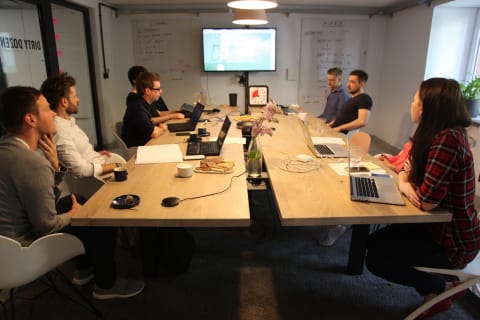Scrum Masters - supporting a workshop approach to problem-solving
Problems, problems, problems. From one perspective, daily life is an endless series of problems – from tiny, one-off challenges, to Gordian Knot level issues that we have to find a way to cut through. Digital product design and development itself is a process focused on solving business problems using technology. In a sense, the whole concept of agile management (and specifically, the Scrum framework) is an approach to solving problems. And while, everyone involved in a Scrum-driven project is a potential problem-solver, the role of Scrum master is key to the process, especially in relation to the support they can give to problem-solving workshops. Read on to see how and using which tools Scrum Master can solve various, product development problems.

Table of contents
What is Scrum?
Scrum is an agile approach to creating new products and services – often used for software, applications, or other IT or technology-related outputs; although the methodology can also be used in other industries, of course.
Scrum is based on delivering a product in a series of successive iterations (called ‘sprints’); usually one or two-week periods of project activity focused on a specific problem (i.e. tasks or features) and resulting in a usable product or part-product.
Due to the nature of these sprints, the longer term project is a process of continuous improvement, not only for the product but also for the Scrum team and its problem-solving.
The Scrum team
Scrum is a team-based approach and for software and technology design and development, we’re usually talking about the development team (often abbreviated to ‘dev team’). Here at Boldare, a typical Scrum team might include frontend and backend developers, a UX designer, a content specialist, a quality assurance specialist, and a business analyst, depending on the nature of the project. And, of course, a Scrum master, whose role it is to keep the team on an ‘agile’ track, following the agreed processes and practices that will result in development of the product.
Scrum teams are characterized by self-organization, i.e., independent work management. The members themselves establish and improve their working methods, divide responsibilities and choose the tools. However, in their daily work, they are united by a common goal, and the person that keeps them focused on that goal is the scrum master. That role is particularly notable in the context of a Scrum problem solving workshop.
The Scrum master supporting role
The fundamental Scrum master role is to ensure the dev team understands and follows Scrum principles, and that kind of support is essential during the workshops described above. As the team finds a collective route through various project issues, the key test for any decision or solution is, does it fit with Scrum?
This is the key role for the Scrum master – to be the touchstone for all things Scrum; to ensure compliance; but also to ensure that the team is leveraging scrum for the best possible impact.
The Scrum master is not the ‘Scrum police’.
Instead, their focus is on helping the team get the most out of Scrum; to access the maximum benefit from working in an agile fashion.
In many ways, the Scrum master takes a facilitator role in problem-solving workshops. They encourage and moderate discussions. They help the team find routes to solutions without dictating what those routes are. The Scrum master makes sure that there is adequate space and time for testing and experimenting. They minimize the constraints created by external factors. They provide the team with all necessary information (or encourage the team to seek out that information).
Furthermore, the Scrum master in the problem solving workshop is an arbiter in the event of conflict – between priorities, between projects, between team members – and is able to keep the team and project moving forward by focusing on the key issues and Scrum principles.
The result is that the dev team is more likely to work without downtime. The team becomes close-knit, with all members working together flexibly and collaboratively. The team also learns from its mistakes (and its successes!)
Scrum problem solving workshops
Every project is essentially a series of problems to be solved. And workshops – either face-to-face or (increasingly) wholly virtual – are a common and effective way to facilitate a team approach to addressing problems.
At Boldare, we are dedicated to using Scrum and we have found a variety of different types of workshop to be critically useful when developing digital products and services, including:
- Product vision workshops – For when you need big picture clarity for the product and its goals. Read
- Event storming – A lightweight and fast process that helps create a business model that can be used during product development. It encourages people specialized in various domains to work on and solve complex business or product problems.
- System story workshops – To create more clarity for the team on the basics of the project: what is it, who is it for, and how will it work?
- User story mapping – For when the team needs to explore in depth how users will interact with the product.
- Impact mapping – A collaborative approach to requirements gathering and planning, this workshop can address issues around exactly what features are needed in the product.
- Design thinking – An iterative approach to design work that works well to focus the whole team on user needs; especially useful when those needs are unclear.
- Planning poker – A workshop activity focused on planning your project, estimating the time and effort necessary for each planned task; helps to build consensus within the team.
(For more on each of these different workshop types, check out our article, Event storming or product vision? Discover workshops that will help to build your next app).
The key principle of servant leadership
The Scrum master role in problem solving workshop is characterized by so-called servant leadership. The Scrum master helps the team to find solutions but does not impose them. In this sense, the role is like a mirror for the team, helping them to see and understand what works and what must be improved, including themselves.
Put simply, at the end of a Scrum project, thanks to the Scrum master, not only has a product or service been created that meets user needs and business priorities, but the dev team members have grown – in skills, knowledge, attitudes, and capacity for great teamwork.
Scrum master - between facilitation and mediation
The Scrum master role in problem solving workshop is one of facilitation and mediation, keeping an eye on the key goals and by doing so, being an effective guide for the dev team and project as a whole. This role is particularly evident in the various types of problem-solving workshops that are used during the Scrum process, especially in the development of digital products and services.
Share this article:









